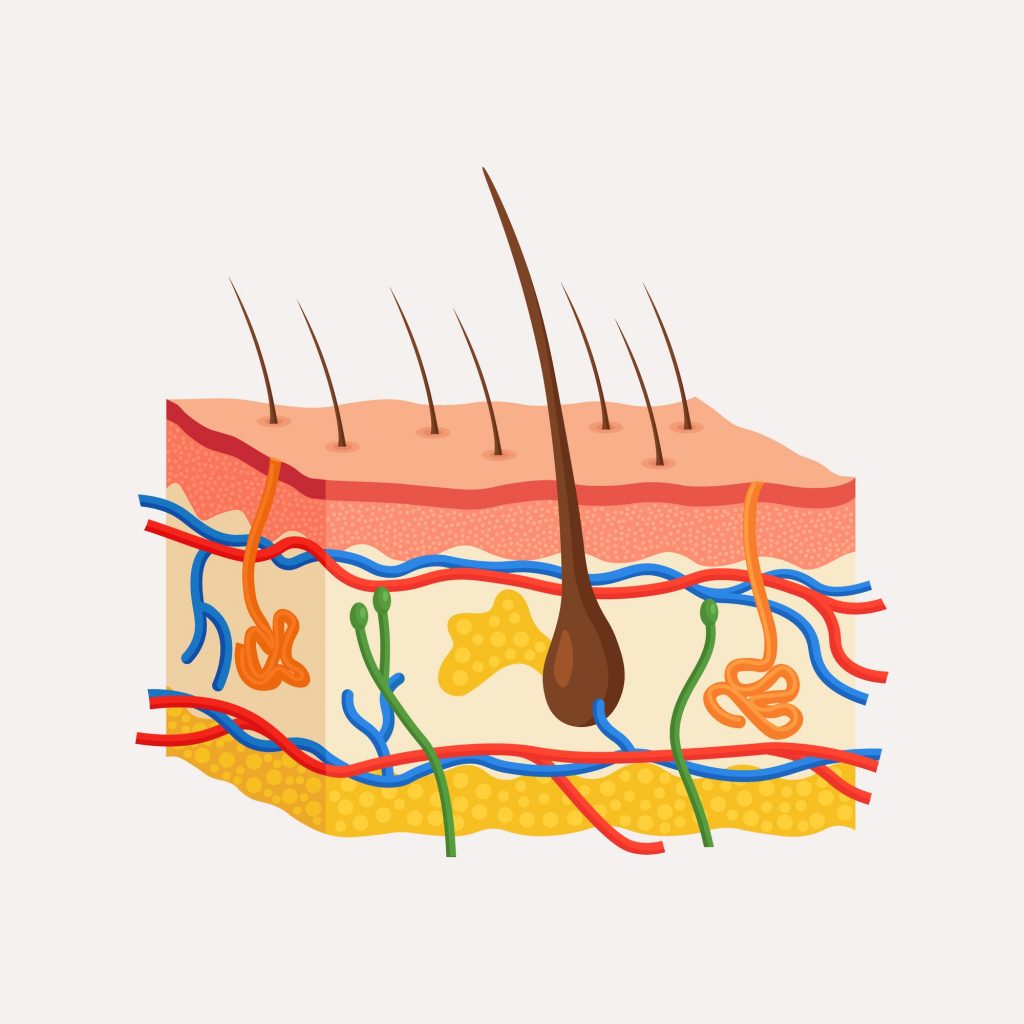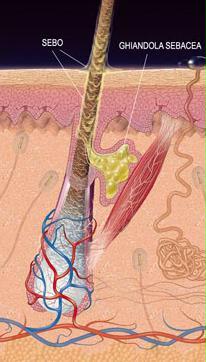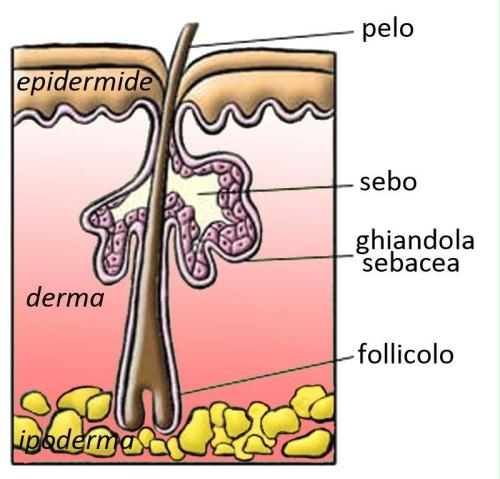- Home
- Sebaceous glands
hair
Sebaceous glands
Scientific collaboration between Professor Marco Toscani and Dr. Pasquale Fino, Chair of Plastic, Reconstructive and Aesthetic Surgery, Umberto I Health Center – “Sapienza” University of Rome.

The sebaceous glands are glands that secrete sebum, an oily, acidic substance with a pH of 3.5. They are connected laterally to the hair follicle. Sebaceous glands are found with a density of approximately 100/cm2 throughout all areas of the skin. In the human body, they are located across the entire surface of the skin, except for the palms of the hands and the soles of the feet. Sebaceous glands are also found in the external auditory meatus (ear canal) and on the eyelids, where they are long and flat. Here they are called tarsal or Meibomian glands.


Sebaceous glands are not distributed homogeneously over the body’s surface. There is a particularly elevated number (400-900/cm2) in the anogenital and in the so-called seborrheic regions (scalp, face, chest and back). In other regions of the body (such as in the forearm area), there are fewer glands. In some areas, like the corners and edges of the lips, the areola, the nipple, the anus, the vaginal libs and the glans (Tyson’s glands), sebaceous glands open directly onto the skin’s surface. They vary in size. They are larger in the pubic area, scrotum and nasal skin and are smaller at the level of the scalp. Like the nail bed and sweat glands, sebaceous glands are characterized by a dense capillary network. The sebaceous gland alveoli and the sweat gland glomeruli are enveloped by perialveolar nerve plexi or periglomerular cells, composed of fibers that lose the myelin sheath near glandular adenomas. In the numerous sweat glands are numerous andrenergic endings at the level of the myoepithelial cells of the glomeruli. Through these, nerve impulses may cause rapid secretions. Secretion cells are instead surrounded by cholinergic fibers. From a histological point of view, we can confirm that sebaceous glands are alveolar glands composed of branched tubes which give them their typical cluster shape. Apocrine sweat secretion is intermittent, while sebum secretion is continuous. The secretion mechanism first leads to an accumulation of sebum in the secretion cells, which increase continuously in volume and size, until they burst. Precisely for this reason not just sebum but also the remaining cells that produced it spill into the hair follicle. This necrosis is then compensated by the continuous production of new cell populations, coming from groups of undifferentiated cells that retained the ability to divide repeatedly. Once formed, the new cells detach from the tube walls and begin to produce sebum, migrating next to the follicle where they dismantle, leaving their contents. Sebaceous gland function is influenced by several factors. Sebaceous gland secretion is controlled by steroid hormones circulating or produced locally by the pilosebaceous follicle, starting from building blocks coming from the gonads or the adrenal cortex (the most active of these is androstanediol). The sebaceous glands produce abundant sebum during fetal development (a fetus’s vernix caseosa). They are active during the first months of life. They then pass to a phase of relative dormancy until 9-10 years of age, and reactivate during adrenarche. They then return to full activity during puberty due to small dermatological phenomena, the epitome of which is the phenomenon of common teenage acne. When there are no particular scalp problems, the production of sebum undergoes an abrupt reduction in women during menopause, while in men it diminishes only very slowly after 60 – 70 years of age. Sebum secretion is also influenced by genetic factors. Greasy skin is often a common problem among members of the same family. The most important factor regulating sebum secretion is the concentration of androgenic hormones, typical of men but also present in small quantities in women. In particular, at the level of the sebaceous glands, we find an enzyme called 5-alpha reductase, which converts delta 4-androstenedione into dihydrotestosterone, a metabolite with the ability to notably increase sebum secretion. Sebum also goes into the composition of hydrolipidic film. This oily mass also contributes to one’s characteristic and personal body odor, to the extent that lipid composition differs slightly from individual to individual. Sebaceous gland cells are enzyme rich and contain glycogen. The sebum that comes out and accumulates on the skin is composed as follows: triglycerides 30-42%, wax 20-25%, free fatty acids 15-25%, squalene 9-12%, branched hydrocarbons 4-8%, esterified cholesterol 2-3%, free cholesterol 1-1.5% and other substances (such as monoglycerides, glycerol, etc.) 3-5%. After being produced, the sebum reaches the surface through gland orifices, hair follicles and wedges into spaces of the disjointed corneum layer, also layering itself onto hair. Thus, it mixes with lipids from the skin and with the aqueous component of perspiration and sweat, forming a thin superficial emulsion called cutaneous hydrolipidic film. Sebum has two main functions. The first is to contribute through sweat to the formation of the hydrolipidic film, an emulsion of water/oil that protects the skin from chemical (detergents, solvents) and bacterial aggressors. The second is to lubricate and waterproof the external surface of the hair as it grows. The sebaceous gland duct opens into the upper part of the follicle in order to lubricate the hair before it appears on the skin’s surface. In normal conditions, total sebum production on the scalp is 650 – 700 mg every 24 hours. After removal via the use of soap, the hydrolipidic film (water/oil emulsion formed by a mixture of sebum with water from sweat) reforms in a relatively short amount of time (3 – 6 hours) but the sebaceous gland does not seem to be able to increase its activity compared to the base values for frequent washes. Sebum is unable to remove itself on its own from the hair shaft. The fact that hair can rapidly “get greasy” again after a wash is due to the reduction of superficial tension between the “keratin shingles” of the cuticle, associated with the continuous rubbing between hair. The speed of sebum migration increases if hair is continuously touched by hands or brushed. Moreover, in individuals with hair that gets particularly greasy in a short amount of time, sebum is more fluid and therefore has a higher migratory capacity. In individuals with seborrhea, the abundance of sebum causes aesthetic issues due to the easy adhesion of environmental dust, keratin residue and waste substances carried by sweat. All too often these problems are accentuated by the effects of applying cosmetics to the hair.
Hair and Scalp
READ ALL ARTICLESHair Loss
READ ALL ARTICLESHair Problems
READ ALL ARTICLESScalp Problems
READ ALL ARTICLESAlopecia
READ ALL ARTICLESPreventions and Solutions
READ ALL ARTICLESHair loss solutions for you. CRLAB, specialists in the well-being of your hair and scalp.
FIND YOUR NEAREST CENTER
Let our experts find the best solution for you.
FIND YOUR NEAREST CRLAB CENTERBOOK A CONSULTATION
Book a consultation with our experts. Find out more about CRLAB solutions.
MAKE AN APPOINTMENTTrichology scalp and hair care
To put the health back into your hair, you first need to nourish your scalp. Our trichology treatments care for your scalp and hair, using cutting-edge technologies with a full range of laboratory-tested products. All made with high quality raw materials.
Find out moreHair prosthetic system
The ultimate answer to your hair loss. Rediscover yourself, with naturally thick hair. A patented solution that integrates real hair into areas where you’re experiencing thinning or hair loss. A fully customized hair enhancement that will look totally natural on you. Plus, it’s so functional, it gives you the freedom to live your life the way you want to.
Find out moreHair transplant surgery
Hair transplantation is recommended for those who wish to improve hair density and coverage. The degree of thinning may vary and must be assessed in relation to the donor area.
Find out more
 Italiano
Italiano  Português
Português  Français
Français  Español
Español 




